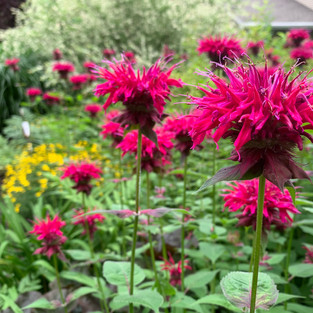This Year Soil Health and Native Plants Take Center Stage
- Patty Carluccio
- Apr 1, 2021
- 3 min read
I’m so excited for gardening this season. On this year’s journey I plan to focus on regenerative gardening. This includes:
· Soil Health
· Native Plants
· Effective On-Time pruning
· Not using synthetic pesticides or fertilizers
Taking care of your soil’s health is the most important thing you can do for your garden and the environment. Healthy soil means healthy plants which can fight off disease and pests. Healthy soil also absorbs rainfall and allows your plants to grow deep roots to survive dry periods.
I’m sticking with my plan to keep gardening simple and reducing the workload. Last fall I left all of my leaves in the beds to protect my plants over the winter. Once the temps hover in the 50s and I see bugs flying around then I’ll start to tidy up.
I don’t want to spend my energy hauling to a compost pile. I’m trying to get rid of the one I have so I’ll be mostly “composting in place” which is really healthy for your garden. The leaf mulch provides so much nutrition to your garden and acts as a wonderful mulch layer to suppress weeds. And, in some areas I’ll put a thin layer of bark mulch “for looks” and to help suppress weeds.
I’m taking the “no-til” method up a notch at my house because every time I disturb the soil I:
· Release weed seeds
· Release carbon into the atmosphere
· Disturb the living organisms in my soil
To control weeds I’ll use my pruners to snip them close to the soil so as not to disturb the roots or soil. The roots will die in place and not disturbing the soil will minimize new weeds. The first time around this will be a pain, but over the season it will get easier. And, as my plants grow bigger they will drown out any weeds.
Why? Soil needs air. The roots go deep into the soil and when they die they leave air in the soil. Worms also break up the soil and make room for air. People til soil to add air, but tilling soil releases carbon into the atmosphere. And, it’s a lot of work. So, I’m leaving it up to Mother Nature to help me out.
I’ll tuck the cut weeds under bushes and big plants to decompose in place. Seed heads will be snipped off and disposed of, maybe. The leaves provide nutrition to my garden. In my vegetable garden I just lay the snipped weeds between the vegetable plants to add to my mulch layer and decompose in place.
New perennials this year will be mostly native to my area in New England. Native plants tend to grow more easily and are good habitat for bees, insects and animal life.
Effective pruning includes not pruning flowering bushes like azaleas and rhododendrons until the weeks after they bloom. The buds set last year and my local bees are looking forward to the flowers, as am I. I will, however, trim branches that are touching the ground to help prevent disease.
And, as always, no synthetic pesticides or fertilizers. If I really need something I’ll seek out only organic so as not to hurt beneficial insects. But, with healthier soil my plants should be healthy enough to withstand most diseases and pests. If it doesn’t make it, it doesn’t make it. I’d rather skip the chemicals and sacrifice an unhealthy plant. I’ll replace it when I divide healthy plants in my yard or maybe try something new.
Happy Gardening!!








Comments